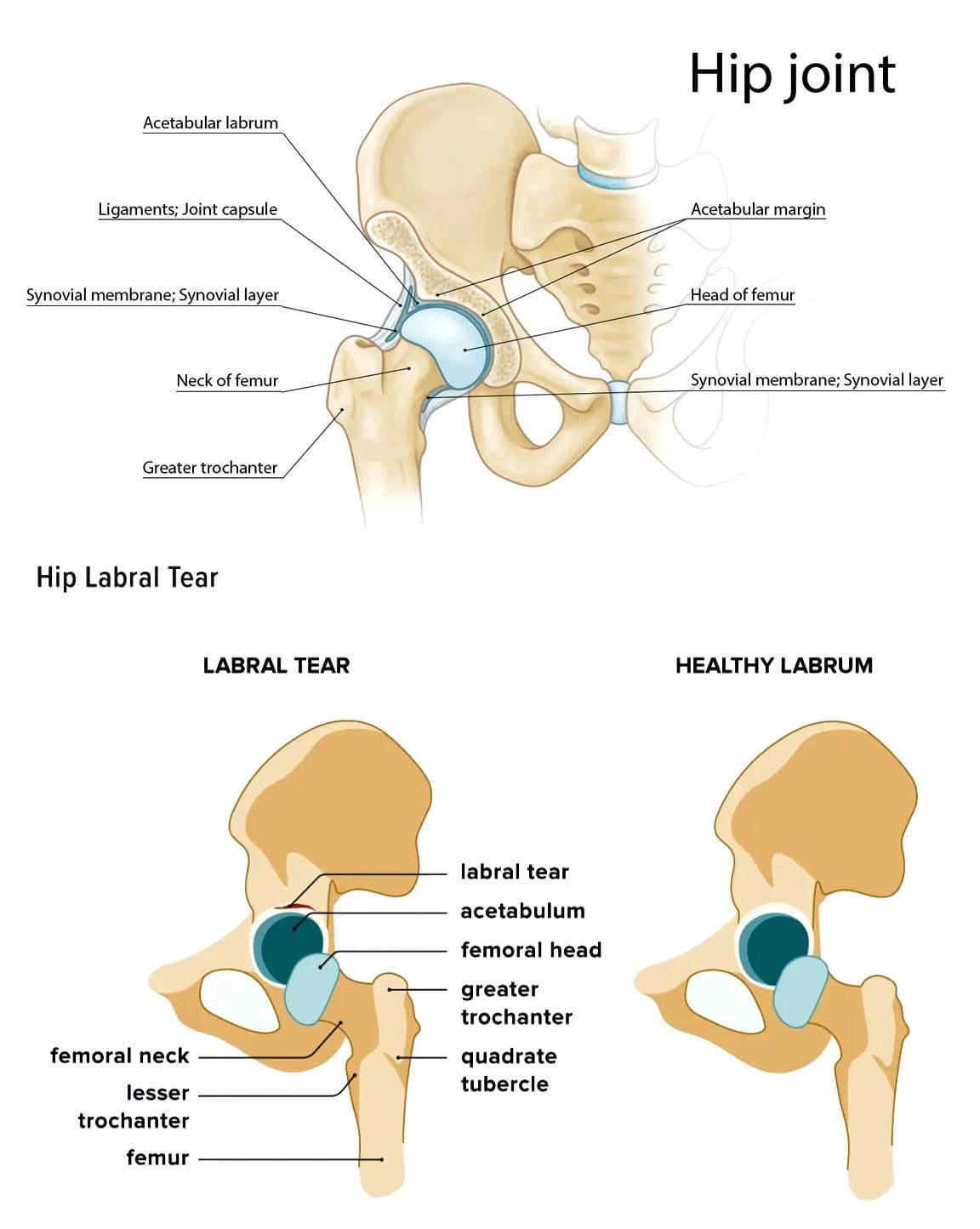The hip joint is a ball-and-socket joint composed of the femur head and a socket, which is part of the pelvis. The labrum is a cartilage ring on the socket part of the hip joint that helps keep joint fluid inside to ensure frictionless hip motion and alignment during movement. A labral tear of the hip is an injury to the labrum. The extent of the damage can vary. Sometimes, the hip labrum can have mini tears or fray at the edges, usually caused by gradual wear and tear. In other cases, a section of the labrum can separate or get torn away from the socket bone. These types of injuries are usually due to trauma. There are conservative hip labral tear tests to determine the type of injury. The Injury Medical Chiropractic and Functional Medicine Clinic team can help.

Contents
Symptoms
Symptoms are similar regardless of the type of tear, but where they are felt depends on whether the tear is in the front or the back. Common symptoms include:
- Hip stiffness
- Limited range of motion
- A clicking or locking sensation in the hip joint when moving.
- Pain in the hip, groin, or buttocks, especially when walking or running.
- Night discomfort and pain symptoms when sleeping.
- Some tears can cause no symptoms and can go unnoticed for years.
Hip Labral Tear Tests
A hip labral tear can occur anywhere along the labrum. They can be described as anterior or posterior, depending on which part of the joint is affected:
- Anterior hip labral tears: The most common type of hip labral tear. These tears occur on the front of the hip joint.
- Posterior hip labral tears: This type appears on the back of the hip joint.
Tests
The most common hip labral tear tests include:
- The Hip Impingement Test
- The Straight Leg Raise Test
- The FABER Test – stands for Flexion, Abduction, and External Rotation.
- The THIRD Test – stands for the Hip Internal Rotation with Distraction.
Hip Impingement Tests
There are two types of hip impingement tests.
Anterior Hip Impingement
- This test involves the patient lying on their back with their knee bent at 90 degrees and then rotated inward towards the body.
- If there is pain, the test is considered positive.
Posterior Hip Impingement
- This test involves the patient lying on their back with their hip extended and their knee flexed and bent at 90 degrees.
- The leg is then rotated outward away from the body.
- If it results in pain or apprehension, it is considered positive.
Straight Leg Raise Test
This test is used on various medical conditions that involve back pain.
- The test begins with the patient sitting or lying down.
- On the unaffected side, the range of motion is examined.
- Then the hip is flexed while the knee is straight on both legs.
- The patient may be asked to flex the neck or extend the foot to stretch nerves.
The FABER Test
It stands for Flexion, Abduction, and External Rotation.
- The test begins with the patient lying on their back with their legs straight.
- The affected leg is placed in a figure four position.
- The physician will then apply incremental downward pressure to the bent knee.
- If there is hip or groin pain, the test is positive.
The THIRD Test
This stands for – the Hip Internal Rotation with Distraction
- The test begins with the patient lying on their back.
- The patient then flexes their knee to 90 degrees and turns it inward around 10 degrees.
- The hip is then rotated inward with downward pressure on the hip joint.
- The maneuver is repeated with the joint slightly distracted/pulled apart.
- It is considered positive if the pain is present when the hip is rotated and diminished pain when distracted and rotated.
Chiropractic Treatment
Chiropractic treatment involves hip adjustments to realign the bones around the hip and up through the spine, soft tissue massage therapy to relax the muscles around the pelvis and thigh, targeted flexibility exercises to restore range of motion, motor control exercises, and strengthening exercises to correct muscular imbalances.
Treatment and Therapy
References
Chamberlain, Rachel. “Hip Pain in Adults: Evaluation and Differential Diagnosis.” American family physician vol. 103,2 (2021): 81-89.
Groh, M.M., Herrera, J. A comprehensive review of hip labral tears. Curr Rev Musculoskelet Med 2, 105–117 (2009). https://doi.org/10.1007/s12178-009-9052-9
Karen M. Myrick, Carl W. Nissen, THIRD Test: Diagnosing Hip Labral Tears With a New Physical Examination Technique, The Journal for Nurse Practitioners, Volume 9, Issue 8, 2013, Pages 501-505, ISSN 1555-4155, https://doi.org/10.1016/j.nurpra.2013.06.008. (https://www.sciencedirect.com/science/article/pii/S155541551300367X)
Roanna M. Burgess, Alison Rushton, Chris Wright, Cathryn Daborn, The validity and accuracy of clinical diagnostic tests used to detect labral pathology of the hip: A systematic review, Manual Therapy, Volume 16, Issue 4, 2011, Pages 318-326, ISSN 1356-689X, https://doi.org/10.1016/j.math.2011.01.002 (https://www.sciencedirect.com/science/article/pii/S1356689X11000038)
Su, Tiao, et al. “Diagnosis and treatment of labral tear.” Chinese medical journal vol. 132,2 (2019): 211-219. doi:10.1097/CM9.0000000000000020
Wilson, John J, and Masaru Furukawa. “Evaluation of the patient with hip pain.” American family physician vol. 89,1 (2014): 27-34.
General Disclaimer, Licenses and Board Certifications *
Professional Scope of Practice *
The information herein on "Hip Labral Tear Tests: El Paso Back Clinic" is not intended to replace a one-on-one relationship with a qualified health care professional or licensed physician and is not medical advice. We encourage you to make healthcare decisions based on your research and partnership with a qualified healthcare professional.
Blog Information & Scope Discussions
Welcome to El Paso's Premier Wellness and Injury Care Clinic & Wellness Blog, where Dr. Alex Jimenez, DC, FNP-C, a Multi-State board-certified Family Practice Nurse Practitioner (FNP-BC) and Chiropractor (DC), presents insights on how our multidisciplinary team is dedicated to holistic healing and personalized care. Our practice aligns with evidence-based treatment protocols inspired by integrative medicine principles, similar to those on this site and on our family practice-based chiromed.com site, focusing on naturally restoring health for patients of all ages.
Our areas of multidisciplinary practice include Wellness & Nutrition, Chronic Pain, Personal Injury, Auto Accident Care, Work Injuries, Back Injury, Low Back Pain, Neck Pain, Migraine Headaches, Sports Injuries, Severe Sciatica, Scoliosis, Complex Herniated Discs, Fibromyalgia, Chronic Pain, Complex Injuries, Stress Management, Functional Medicine Treatments, and in-scope care protocols.
Our information scope is multidisciplinary, focusing on musculoskeletal and physical medicine, wellness, contributing etiological viscerosomatic disturbances within clinical presentations, associated somato-visceral reflex clinical dynamics, subluxation complexes, sensitive health issues, and functional medicine articles, topics, and discussions.
We provide and present clinical collaboration with specialists from various disciplines. Each specialist is governed by their professional scope of practice and their jurisdiction of licensure. We use functional health & wellness protocols to treat and support care for musculoskeletal injuries or disorders.
Our videos, posts, topics, and insights address clinical matters and issues that are directly or indirectly related to our clinical scope of practice.
Our office has made a reasonable effort to provide supportive citations and has identified relevant research studies that support our posts. We provide copies of supporting research studies upon request to regulatory boards and the public.
We understand that we cover matters that require an additional explanation of how they may assist in a particular care plan or treatment protocol; therefore, to discuss the subject matter above further, please feel free to ask Dr. Alex Jimenez, DC, APRN, FNP-BC, or contact us at 915-850-0900.
We are here to help you and your family.
Blessings
Dr. Alex Jimenez DC, MSACP, APRN, FNP-BC*, CCST, IFMCP, CFMP, ATN
email: coach@elpasofunctionalmedicine.com
Multidisciplinary Licensing & Board Certifications:
Licensed as a Doctor of Chiropractic (DC) in Texas & New Mexico*
Texas DC License #: TX5807, Verified: TX5807
New Mexico DC License #: NM-DC2182, Verified: NM-DC2182
Multi-State Advanced Practice Registered Nurse (APRN*) in Texas & Multi-States
Multi-state Compact APRN License by Endorsement (42 States)
Texas APRN License #: 1191402, Verified: 1191402 *
Florida APRN License #: 11043890, Verified: APRN11043890 *
License Verification Link: Nursys License Verifier
* Prescriptive Authority Authorized
ANCC FNP-BC: Board Certified Nurse Practitioner*
Compact Status: Multi-State License: Authorized to Practice in 40 States*
Graduate with Honors: ICHS: MSN-FNP (Family Nurse Practitioner Program)
Degree Granted. Master's in Family Practice MSN Diploma (Cum Laude)
Dr. Alex Jimenez, DC, APRN, FNP-BC*, CFMP, IFMCP, ATN, CCST
My Digital Business Card
Licenses and Board Certifications:
DC: Doctor of Chiropractic
APRNP: Advanced Practice Registered Nurse
FNP-BC: Family Practice Specialization (Multi-State Board Certified)
RN: Registered Nurse (Multi-State Compact License)
CFMP: Certified Functional Medicine Provider
MSN-FNP: Master of Science in Family Practice Medicine
MSACP: Master of Science in Advanced Clinical Practice
IFMCP: Institute of Functional Medicine
CCST: Certified Chiropractic Spinal Trauma
ATN: Advanced Translational Neutrogenomics
Memberships & Associations:
TCA: Texas Chiropractic Association: Member ID: 104311
AANP: American Association of Nurse Practitioners: Member ID: 2198960
ANA: American Nurse Association: Member ID: 06458222 (District TX01)
TNA: Texas Nurse Association: Member ID: 06458222
NPI: 1205907805
| Primary Taxonomy | Selected Taxonomy | State | License Number |
|---|---|---|---|
| No | 111N00000X - Chiropractor | NM | DC2182 |
| Yes | 111N00000X - Chiropractor | TX | DC5807 |
| Yes | 363LF0000X - Nurse Practitioner - Family | TX | 1191402 |
| Yes | 363LF0000X - Nurse Practitioner - Family | FL | 11043890 |








